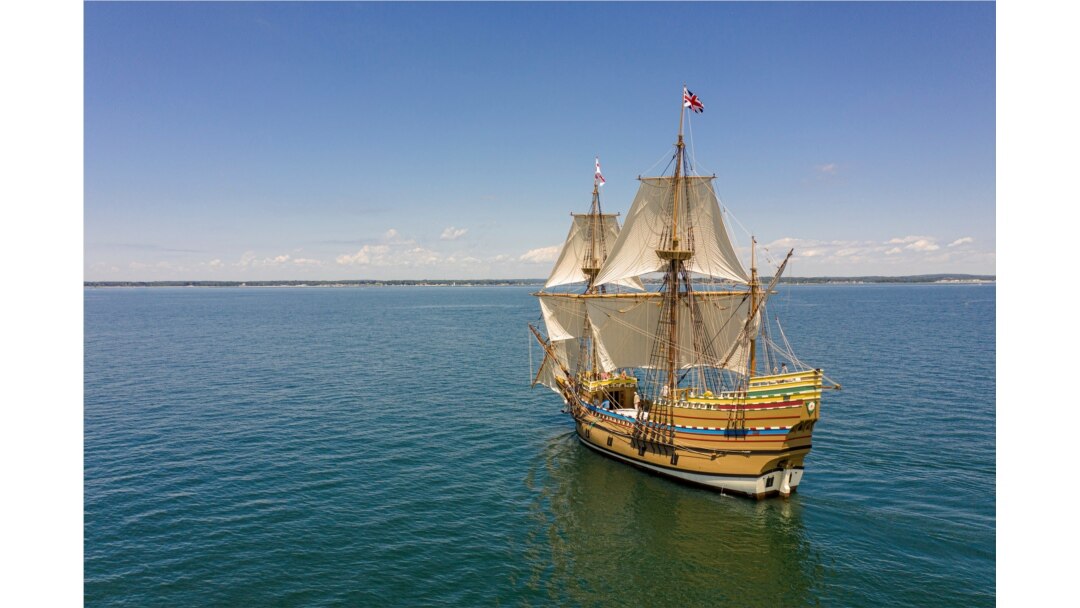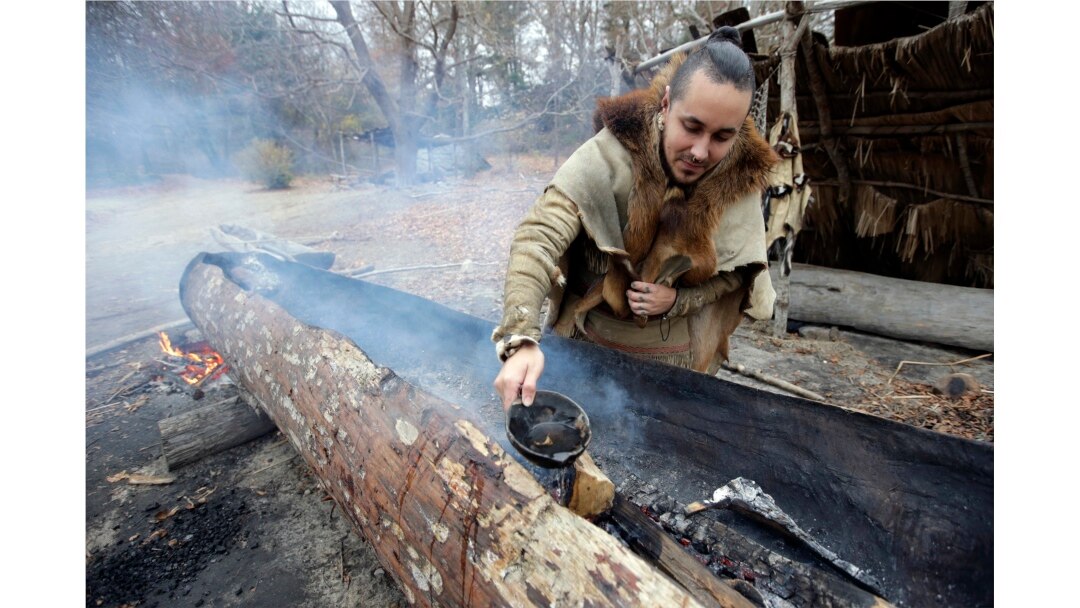In July 1620, the Puritan separatists known as Pilgrims returned to England from exile in the Netherlands and set sail for America, looking to freely express their religious beliefs, free from Anglican Church or royal interference.
After weeks at sea and a month exploring Cape Cod, they settled on Plymouth Harbor as a suitable site to build their colony.

Mayflower II, a full-scale reproduction of the tall ship that brought the Pilgrims to Plymouth in 1620. Massachusetts Office of Travel and Tourism.
Plymouth Colony remained an independent colony for more than 70 years until it was absorbed into the Massachusetts Bay Colony in 1691. In that time, its population grew from fewer than 200 to about 4,000.
For the first few decades, Pilgrims and local tribes were able to live side by side in peace. But the next five decades brought successive waves of English migrants and increased tension over land and sovereignty.
Puritans' efforts to “civilize” and Christianize Native Americans disrupted tribal unity, culture and spirituality. The outbreak of King Philip’s War in 1676 ended all Native hope of pushing English colonists off of land their ancestors had occupied for more than 10,000 years.
Historians have traditionally relied on the Pilgrims’ own writings to tell the Pilgrims' story. But these accounts fail to describe some of the uglier aspects of colonization and how they impacted local tribes.
New England Natives relied on oral storytelling and creative memory devices to keep their histories alive, but colonialism disrupted these traditions. Sadly, say tribes, most of that history was lost.
To tell the story more completely, VOA conducted dozens of interviews with scholars and historians, both Native American and non-Native, and combed through both Pilgrim writings and prominent contemporary histories. In this series, we will explore the history left out of textbooks: key Native leaders and personalities; cultures and spiritual systems; colonial systems of cultural and religious assimilation; slavery; the Native experience abroad; and even the ways in which New England tribes have reconnected with long-lost cousins overseas.

Mashpee Wampanoag Phillip Wynne pours water to control fire and temperatures while making a boat, from a tree at the Wampanoag Homesite at Plimoth Plantation, in Plymouth, Mass.
Who were the players?
The Pilgrims dreamed of establishing a new “Jerusalem” in which they could live in peace and brotherhood while waiting for the second coming of Christ. They believed their duty was to convert Native people to Christianity and assimilate them into the English way of life.
The Wampanoags in Massachusetts were wary of the newcomers yet looking for trade and military alliances. They had good reason to mistrust the Pilgrims: English explorers had been kidnapping Natives along the Northeastern coast since the early 1500s. Old World diseases had devastated Native populations; a recent epidemic had wiped out some 90% of the Wampanoag population, leaving them vulnerable to their enemies in Rhode Island, the Narragansetts.
In March 1621, after months of watching the Pilgrims from a distance, Juaquin, the Wampanoag’s Massasoit or paramount leader, approached the English to negotiate.
With this first outreach an American tradition began. The Wampanoag, both out of compassion and political expediency, helped the Pilgrims to plant their first harvest and, in autumn 1621, participated in a harvest feast that generations of Americans have commemorated as “Thanksgiving.”
Thousands more English would cross the Atlantic over the next decade. Most were Puritans who, unlike the Pilgrims, wanted to remain part of the Church of England. They settled a second colony, the Massachusetts Bay Colony, in 1630.
This 1638 woodcut shows the English, Mohegan and Narragansett attack and torching in 1637 of a Pequot village at Missituck which left 400 Pequot men, women and children dead, many of them burned to death.
During that time, Massachusetts colonists also began expanding their settlement into the area that is now Connecticut.
Tensions over control of territory and trade now forced tribes into alliances with the English and Dutch, who also had interest in the region. This pitted tribes against one another, upsetting the political and economic balance that had been existed in New England for generations.
Christianity
The Mayflower Compact, drafted before the Pilgrims set foot in Plymouth, stated they had undertaken their voyage “for the glory of God, and advancement of the Christian faith.”
The 1629 Massachusetts Bay Charter spelled out what its Puritan founders believed was a divine mandate to “win and incite the Natives of the country to the knowledge and obedience of the only true God and Savior of mankind.”
In 1646, John Eliot, the Puritan missionary of the Massachusetts Bay Colony, began preaching and established the first of 14 “praying towns” in which Indians, forced to eschew their traditional lives, would live, work, convert and worship as English Puritans.
The Mayflower Compact, the first governing document of Plymouth Colony, signed November 11 in what is now Providence Harbor, Massachusetts.
But Eliot’s experiment came at great cost to the “praying Indians.” Epidemics, poor weather, crop failures and debt took their toll on the Christianized Indians and led to conflicts with non-Christian Indians.
Plymouth’s alliance with the Wampanoag confederation began to unravel in the early 1660s when Metacom — who was given the anglicized name of King Philip — came to power. Up until this point, Plymouth generally regarded the tribe as a sovereign nation. But gradually, Plymouth began imposing its own laws on the tribe and required them to pay the colony a stiff annual tribute.
Turning point
The final insult occurred in June 1675, when three of his counselors were accused of the murder of a Christian Indian, a matter that should have been settled by the Wampanoag judicial system. Instead, the Plymouth Court tried, convicted and hanged the men.
In retaliation, Wampanoag warriors raided the Puritan frontier settlement of Wethersfield, Connecticut, triggering a 14-month war known by the English as “King Philip’s War,” the bloodiest conflict per capita in American history.
It ended after English soldiers captured Metacom in August 1676. From this point onward, Native Americans were no longer the dominant power in the region and became subjects of the English Crown and, later, subjects of the U.S. government once the colonies achieved independence from Britain in 1776.
"Philip, King of Mount Hope", from Benjamin Church's "The Entertaining History of King Philip's War," line engraving, colored by hand, by American engraver and silversmith Paul Revere.
Flourishing today
Historic accounts and popular legend have traditionally suggested that New England tribes disappeared. They did not. Today, the federal government recognizes five tribes in southeast New England, whose citizens are reconnecting with the past, revitalizing language and culture, and preparing their youth for the future.
In Massachusetts:
The Mashpee Wampanoag Tribe in Mashpee and Taunton. (2,600 citizens)
The Wampanoag Tribe of Gay Head (Aquinnah) in Martha’s Vineyard, Massachusetts. (1,365 citizens)
In Connecticut:
The Mashantucket Pequot Tribe of Connecticut in Ledyard and Preston (1,090 citizens).
The Mohegan Indian Tribe of Connecticut in Uncasville, Connecticut (2,000 citizens).
In Rhode Island:
The Narragansett Indian Tribe of Rhode Island in Charlestown and Waverly (2,400+ citizens).


